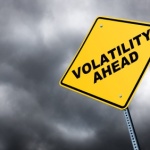Volatility In Stocks – That’s A Good Thing
The U.S. stock market got quite volatile last week, and I couldn’t be happier. Let me explain why, by way of the analogy of the 2011 fire at Lost Pines State Park.

Bastrop Fire aftermath, 2011
Scorched earth and equity markets
Two weeks ago, I drove with my family near Lost Pines Forest, the ground zero of a devastating forest fire in 2011 that Wikipedia tells me was the most destructive wildfire in Texas history.
I had passed through Bastrop just weeks after that fire on our way to College Station, and I remember how utterly desolate the roadside forest appeared. Just a terrible vista of charred chimneys, missing their houses. Blackened trunks perched on scarred ground.
Now, however, the ecosystem is roaring back.
Fire leads to new growth
A friend of mine who teaches biology at Trinity University in San Antonio — she studies grassland ecosystems in particular — confirms what you can observe now at Lost Pines. The incredible rate of regrowth of the Lost Pines Forest happens because of the devastating fire.
In many areas, grass and forest ecosystems depend on periodic fires to remain healthy. The fire spurs growth. No fire in the past leads to less healthy growth in the future.

Regrowth of scorched earch
The forest fire stock market analogy
Just like periodic forest fires keep ecosystems healthy for grasses, plants and trees, periodic market crashes keep stock markets healthy for you and me, as long-term investors.
I credit Morgan Housel at the finance website Motley Fool for introducing me to this idea first — that stock markets must crash periodically in order to provide a decent return for the rest of us.
We typically complain, or fret, about stock market volatility. But you know what? That’s the wrong approach. The crashes help repel other people’s money from the market, which allows us long-term investors to earn a positive return.
To be perfectly clear about what I mean with my analogy: We need markets to crash periodically in order for them to “do their job” for us, which is to provide a decent positive return on our long-term surplus capital.
This positive view of market crashes — the financial equivalent of devastating wildfires — is so counterintuitive to our way of thinking and talking about the stock market that it just may alter the way you view the peripatetic ups and downs of equity markets. I hope so. That’s the point of this post.
Now, how exactly does it work that crashes and volatility are the keys to a decent positive long-term return for you, the long-term investor?
Think for a moment what the investment world would be like if stock markets always stayed stable. Zero volatility. Zero crashes. And let’s say in that stable world that stocks initially returned an average of 6 percent per year.
The only rational thing to do, with a market that provided that kind of positive return and perfect stability, would be for everyone to empty their bank accounts and pour money into the stock market. If people felt safe, they would put all their money into the stock market.
That decision by everybody would raise the price of stocks so much that future returns on stocks would decline, to something much less attractive. Given perfect stability, the market would attract as much money as it could take until future returns would approach the returns of other stable, store-of-value vehicles, like bank accounts.

Which is to say, if stocks were completely stable, we would all buy them until they offered a roughly 0 percent future return, just like bank accounts.
But the fact that you can get burned in stocks is exactly why not everybody empties out their banks accounts to bid up the prices of stocks. This relative scarcity of stock market capital leaves space for growth, like a forest that’s been cleared by a fire.
Stocks, thankfully, are not stable. People don’t feel safe. And that’s a good thing.
Do you need your money back before five years? Don’t bother with stocks. You may get burned.
The fact that people who need their money back within five years shouldn’t go anywhere near stocks — due to volatility — is part of the reason why stocks provide longer-term investors with a return above 0 percent.
Without crashes, the stock market would attract too much money. The periodic crash is therefore not a failure of markets or a glitch in the system. On the contrary, the periodic crash — like the forest fire — is a key to the whole system working correctly.
Here’s the topsy-turvy — but nevertheless true — logic of the relationship between volatility and stock market returns: Total stability would lead to “pricing for perfection,” which in turn could be destabilizing when underlying companies and the economy failed to achieve perfection. A volatile market, by contrast, stays just unattractive enough for short-term and speculative investors to allow for predictable, positive, long-term returns for long-term investors.
Long live the forest fire! Long live the volatility!
Honest and Reflective Conversation about Finance © 2013 Bankers Anonymous.
Be sure to more




I liked the analogy. Volatility certainly can be a good thing in the stock market. In addition to shaking out weak hands, volatility can also be a good thing if you're invested in a riskier position that sees a large increase in share price. The important thing for a long-term investor is to make sure they have enough cash on hand, otherwise in a volatile market, they may find themselves obligated to sell at the bottom.